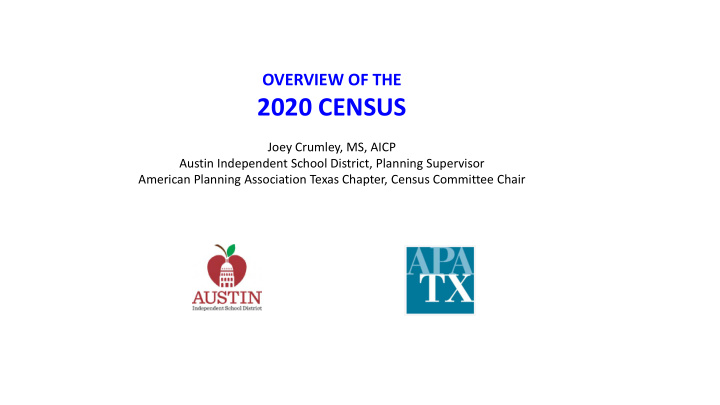



OVERVIEW OF THE 2020 CENSUS Joey Crumley, MS, AICP Austin Independent School District, Planning Supervisor American Planning Association Texas Chapter, Census Committee Chair
WHAT IS THE CENSUS? • The U.S. Constitution requires a count of everyone living in the country every ten years, which is known as the Decennial Census. • The Census has been conducted every ten years since 1790. • Every residence receiving a notice must answer the Census form completely. This is a legal requirement.
WHY IS THE CENSUS IMPORTANT? • The Census determines the number of seats each state gets in the U.S. House of Representatives. • It is projected that Texas could gain three to four additional Congressional seats based on a complete 2020 Census count. • The Census is also used to determined political district boundary lines at the federal, state, and local levels. • In Texas alone, the Census is used to determine the allocation of $60 billion in federal funding annually to state and local agencies.
WHY IS THE CENSUS IMPORTANT? • Many important programs and services are affected by Census-based funding, such as the following: Public education (Title I, special education, free and reduced lunch, etc.) College loans and grants Nutritional and medical assistance Housing assistance Highways Water, wastewater, and waste disposal projects • Census data inform businesses where to locate, developers where to build houses, and governmental entities where to apply resources.
WHO HAS TO BE COUNTED? • Anyone who is living most of the time (i.e., 183 days out of the year) in the U.S. or its territories as of April 1, 2020, regardless of citizenship status or nationality. This includes persons with green cards or visas. This does not include people from other countries who are in the U.S. just on business trips or visiting. • Everyone living most of the time at a residence receiving a notice must be counted. This includes infants and children, other relatives, and non-relatives. • There are special counting methods for individuals living in group quarters such as college dorms and prisons, and those stationed in the military.
WHAT ARE CENSUS BUREAU SURVEYS? • Whereas the Decennial Census is administered every ten years, the Census Bureau also administers annual surveys, such as the American Community Survey and the American Housing Survey. • And, whereas the Decennial Census strives to reach every residence in the U.S., these surveys are administered to a relatively small sample of residences around the country. But, based on the sample data collected, national, state, and local estimates are statistically determined. • Just like the Decennial Census, participation in these surveys is a legal requirement. If you happen to receive a Decennial Census notice and a survey notice in the same year, you must complete both.
HOW ARE OUR COMMUNITIES HELPING? • Across the country, governmental entities and various organizations have formed Complete Count Committees (CCCs), with guidance and support from the Census Bureau. In Texas alone, there are over 700 CCCs at work. • CCCs form subcommittees to focus on populations at risk of being undercounted, which include: Children, especially ages 0-5 Single-parent households Renters and highly mobile populations Persons of color and with limited English proficiency Immigrants Seniors and disabled persons
2010 Census Undercounted Areas in Texas
HOW CAN I GET MORE INFORMATION? • Austin ISD has a Census website, at https://www.austinisd.org/census2020 . • The Austin ISD website includes a concise informational flyer in English, Spanish, and Vietnamese, and a nice video on the Census. • The Austin ISD website links to the Census website of the American Planning Association Texas Chapter, at https://texas.planning.org/community- outreach/2020-census/ . • The APATX website includes numerous resources, many of which come from the Census Bureau, but with other resources from various perspectives, including educational, governmental, and business.
HOW CAN I GET MORE INFORMATION? • The Texas Demographic Center at https://demographics.texas.gov/ is always a great source for Texas demographic data at the state, county, and local levels, but they have really geared up for the 2020 Census. • And, last but certainly not least, there is the official 2020 Census website itself at https://2020census.gov/en . • This website contains a wealth of factual information. The “Partners” menu selection includes a number of topical handouts and toolkits. And, the “Educators” menu selection has Census related resources for classroom teachers at all levels.
Recommend
More recommend